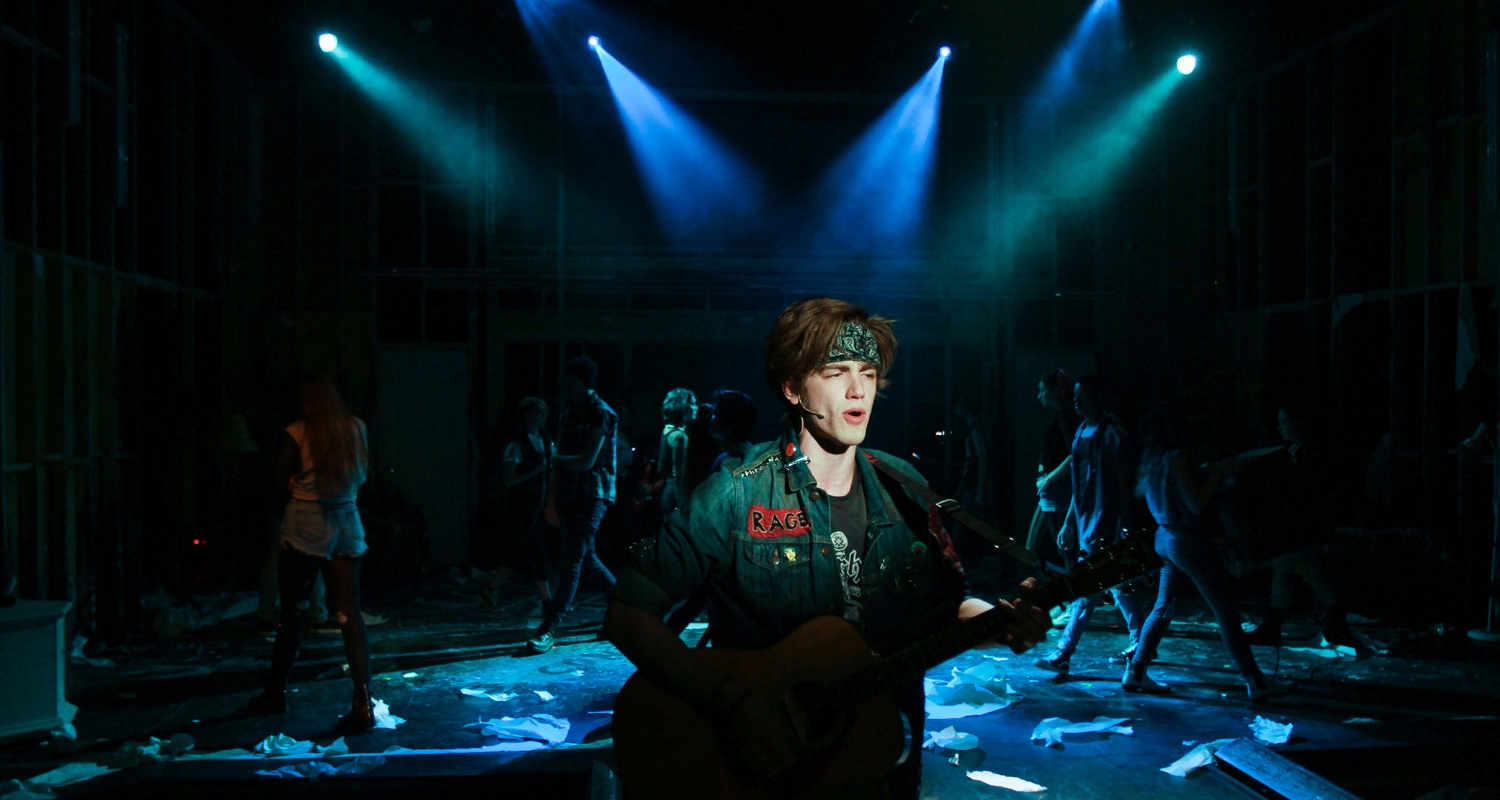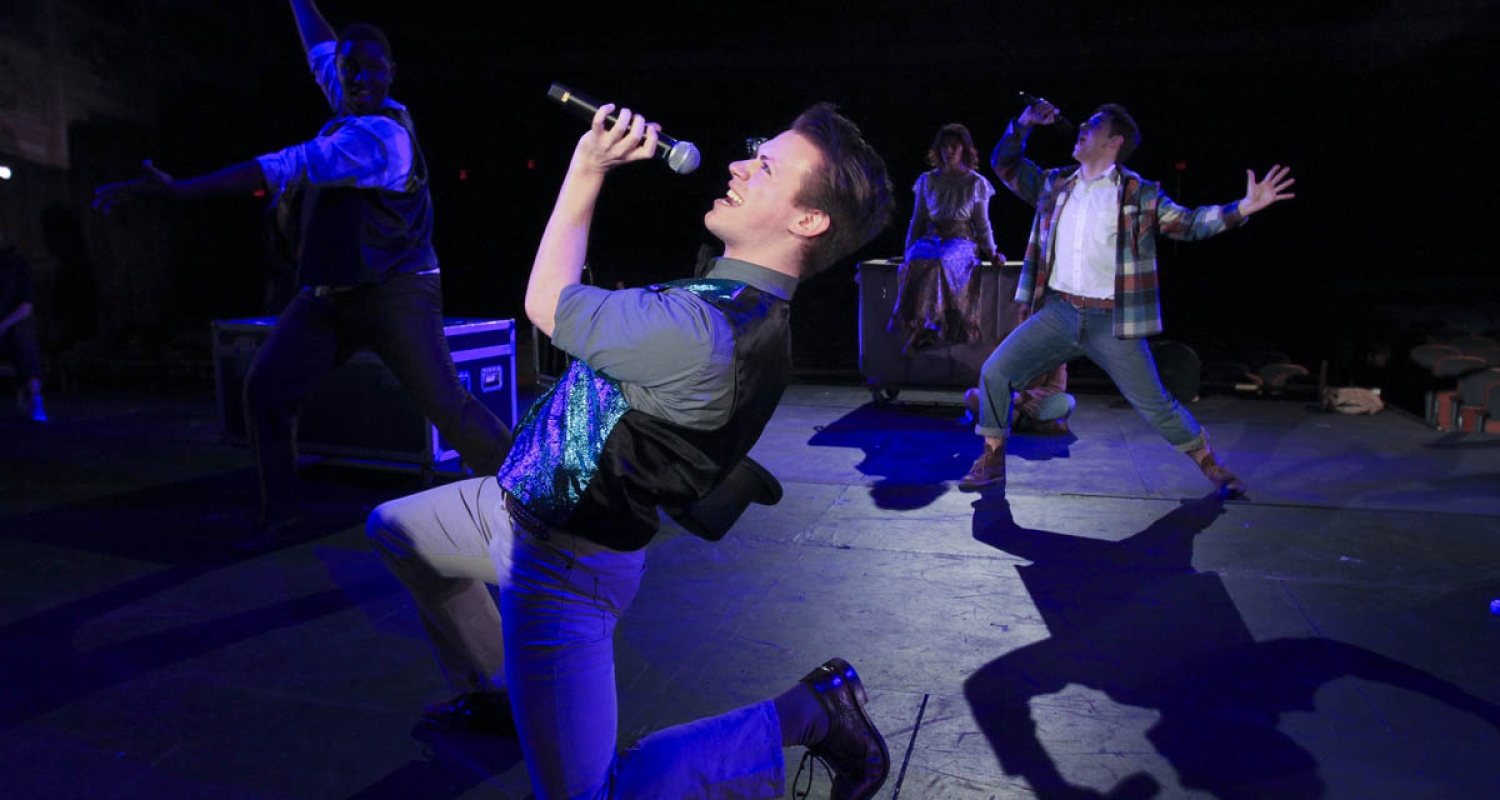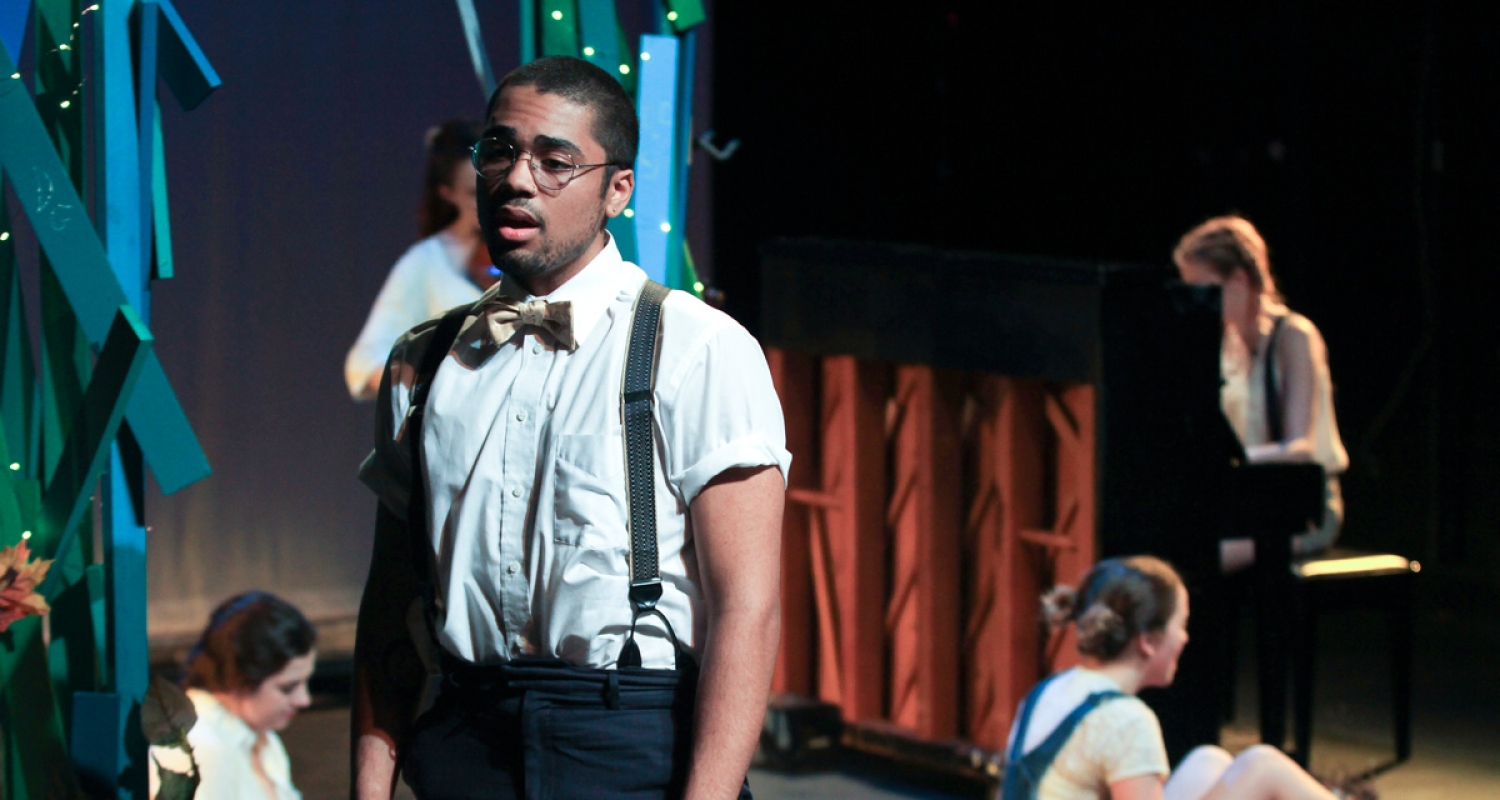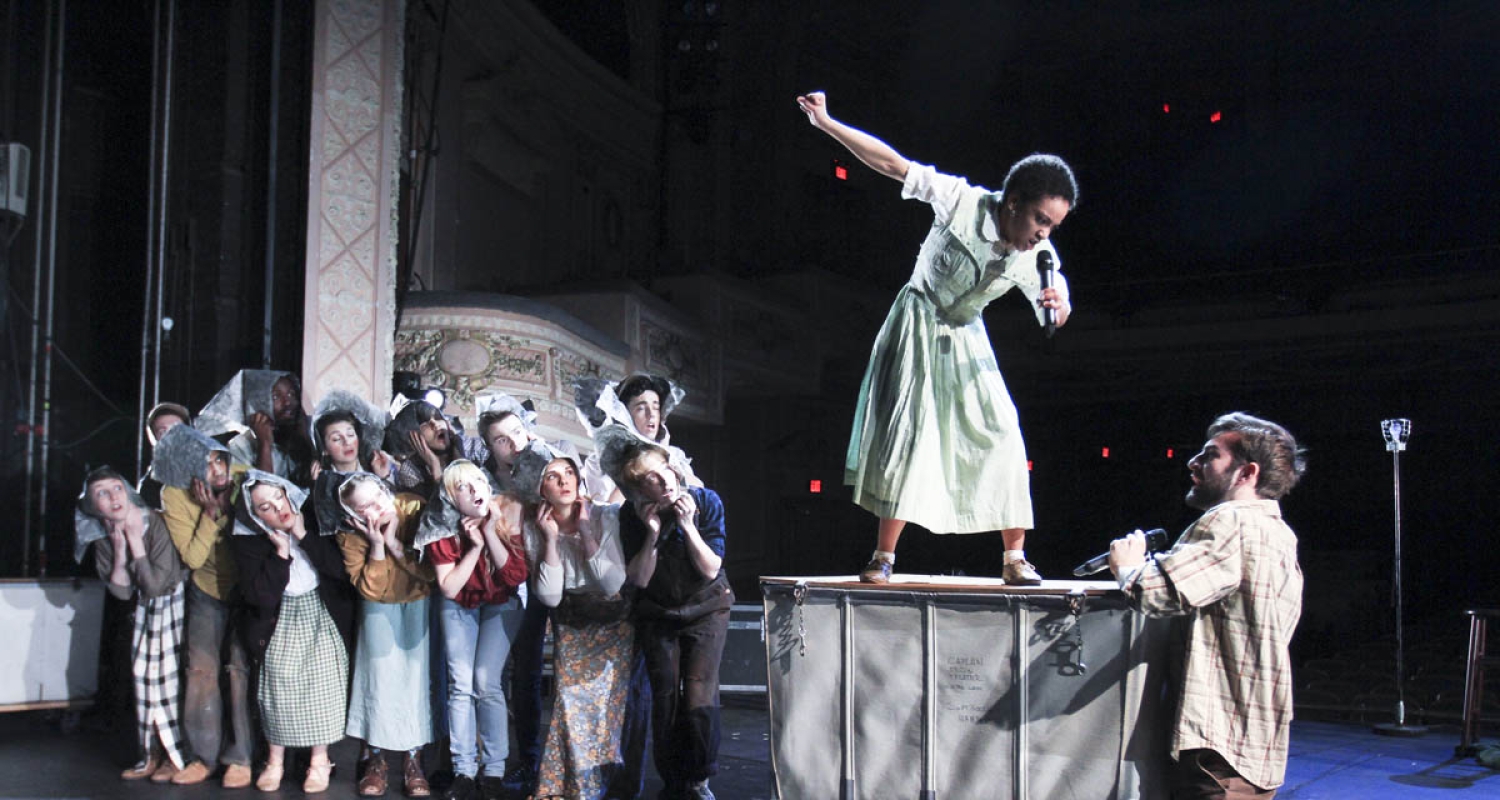



Theater Auditions
Undergraduate performing arts applicants will select their audition date through their applicant portal after submitting their application. There are no prescreening requirements. All School of Theater applicants are required to complete an audition or interview before they will receive an admissions decision. UArts hosts both on-campus and virtual audition days. View our 2023-2024 audition day schedule.
In-Person/On-Campus Auditions
What to Expect
If participating in an in-person/on-campus audition day, you’ll complete a short information form about your prior experience and goals, meet with current students and faculty, and complete your individual audition or interview.
Acting applicants should bring their headshot and résumé to their audition day and be prepared for the repertoire described below. Your audition will include your initial presentation of your prepared repertoire and a personal interview. You might receive a callback, during which you will perform your prepared work for a second time, complete another personal interview, and might complete a brief improvisation. Auditions completed at a Unifieds event will not include a callback component or dance call. All Acting applicants will also be asked to upload recordings of their audition repertoire via their applicant portal. See below for major repertoire requirements.
Musical Theater applicants should bring their headshot and résumé to their audition day and be prepared for the repertoire described below, including sheet music for accompanying songs. Musical Theater auditions are held in two parts: Part one is your initial presentation of your prepared repertoire, a personal interview and a dance call. The dance call does not impact an applicant’s admission decision. After your initial presentation of your audition materials, you might be asked to stay and present your material a second time, either for the same adjudicator or a different adjudicator. (This is not a traditional callback. If you are not asked to present your materials a second time, it does not mean that you are not being considered for admission to the program). Auditions completed at a Unifieds event will not include a callback component or dance call. All Musical Theater applicants will also be asked to upload recordings of their audition repertoire via their applicant portal. See below for major repertoire requirements.
Theater Design and Technology and Directing, Playwriting, and Production applicants should bring a portfolio of work, as described below, and be prepared to either leave a hard copy with the department or provide a link to view all work online (GoogleDrive, etc).
Virtual Auditions
What to Expect
If participating in a virtual audition day, you must upload the following items to your UArts applicant portal at least two weeks before your audition day:
- Headshot and Resume
- Information form (available in your portal)
- Major repertoire or portfolio; see below for specific requirements
- A repertoire or portfolio description list that outlines titles, roles, project descriptions, etc.
- A “wild card” video: In 3 to 5 minutes, tell us about who you are outside your prepared submissions. Tell us about your artistry, goals and interests.
During the virtual audition, you will participate in a welcome from the School of Theater, attend a Q&A with faculty and current students, join a group warmup, and complete your individual audition or interview.
Can’t Make an Audition Day?
In extenuating circumstances, students who can’t make an audition day are allowed to submit their materials for asynchronous review. A live audition, either in person or virtual, is strongly preferred. Students participating in an asynchronous audition may still be asked to complete an individual interview via phone or Zoom, once they have uploaded the following items to their UArts applicant portal:
- Headshot and Resume
- Information form (available in your portal)
- Major repertoire or portfolio; see below for specific requirements
- A repertoire or portfolio description list that outlines titles, roles, project descriptions, etc.
- A “wild card” video: In 3 to 5 minutes, tell us about who you are outside your prepared submissions. Tell us about your artistry, goals and interests.
UArts reserves the right to re-audition any applicant admitted on the basis of a submitted audition. In such cases, the university also reserves the right to reconsider and withdraw the original offer of admission or scholarship, if necessary.
Major Repertoire & Portfolio Guidelines
Click your program below to learn about audition and portfolio requirements.
Two contrasting monologues (such as one comedic and one dramatic, or one classical and one contemporary, etc.); the total time for both monologues should not exceed three minutes.
TIPS
-
Each piece should be filmed/uploaded as a separate piece of media. No continuous videos. Students are encouraged to use standard technology/recording devices that are available to them (i.e. smartphones, tablets, etc.)
-
Monologues should be fully memorized, and should be from a published play script. No self-written work or TV/film scripts, please.
-
Include an introduction (“slate”) on each video; there should not be a separate introduction or “slate” video. Instead, “slates” are to appear at the beginning of each piece and included as part of the time allotment. The proper slate for a monologue is to share your name, the title of the play, and the playwright.
While University of the Arts does not require a Prescreen submission as part of the application process, UArts uses the Musical Theater Common Prescreen requirements for audition submissions.
-
Two 60-90 second songs from contemporary musicals (any musical written after 1970) and contrasting in style; one ballad and one up-tempo, with musical accompaniment.
-
One 60-90 second monologue; must come from a published play, typically written after 1950.
-
One 30-60 second solo dance; style of your choice, filmed in “full frame”, and must include at least one turn, one jump and one kick (or other suitable rotation, elevation, and extension that works for your body).
-
For virtual and asynchronous auditions only: One “wild card” video
See below for additional repertoire requirements and tips.
PORTFOLIO MATERIAL
Each piece should be filmed/uploaded as a separate piece of media. No continuous videos. Students are encouraged to use standard technology/recording devices that are available to them (i.e. smartphones, tablets, etc.)
INTRODUCTION (“SLATE”)
There should not be a separate introduction or “slate” video. Instead, slates are to appear at the beginning of each piece and included as part of the time allotment.
-
The proper slate for a song is to share your name, the song title, and show in which it appears.
-
The proper slate for a monologue is to share your name, the title of the play, and the playwright.
-
The proper slate for a piece of dance is to share your name, the title of the song you are dancing to, and the name of the choreographer. If the piece is “self-choreographed” you should share your own name as choreographer.
SONGS
-
Style: one song should be a ballad (where the piece has longer, sustained vocal lines) and one song should be up-tempo (where the vocal line moves at a conversational pace) so as to contrast style.
-
Length: Each song file should be 60-90 seconds (This time limit includes the slate at the beginning of the piece and is strictly adhered to; please do not upload media files longer than 90 seconds.)
-
Accompaniment: Students must sing to musical accompaniment, which could include live or pre-recorded accompaniment. No “a cappella” singing (meaning singing without music.)
MONOLOGUE
One monologue (typically written after 1950), 60-90 seconds in length. The monologue should be filmed in a “close-up” shot which means the top of the head to the chest should be visible in the frame.
-
Monologues must be from a published play.
-
Monologues cannot be from musicals.
-
Each monologue file should be 60-90 seconds (this time limit includes the slate at the beginning of the piece and is strictly adhered to; please do not upload media files longer than 90 seconds).
DANCE
30-60 seconds of dance in whatever dance discipline you feel most confident.
This may include, but is not limited to jazz, ballet, tap, modern, hip hop, lyrical, contemporary, or dance styles beyond American and Euro-western styles.
Please use steps, movement, and physical vocabulary that you are familiar with and can execute well to the best of your ability, move your body fully. Please include at least one turn, one jump and one kick (or other suitable rotation, elevation, and extension that works for your body). Dance media can be “self-choreographed”, but it must be a solo video of you. This can include a show, competition, or other performance so long as you are clearly featured on your own.
-
Framing: All dance media should be filmed in a “full frame” shot taking care to keep the student’s entire person in the frame at all times. (This time limit includes the slate at the beginning of the piece and is strictly adhered to; please do not upload media files longer than 60 seconds.)
-
Style: Regardless of which style of dance you execute, the choreography and the movement should be connected to the music where the applicant is dancing with a sense of purpose.
-
All choreography must be performed to music; please no “a cappella” dance media.
WILD CARD
-
Applicants do not need to slate in any wild card media.
-
This media can be ANYTHING you want - a special skill, an interesting story about yourself, a passion speech, an instrument you play, etc. “What do you want us to know about you?” and “What makes you unique?”
OVERALL TIPS: SET UP YOUR RECORDING SPACE
-
Find a space where you can move around freely taking care to move items that might impede your creative exploration. This is especially important for dance and movement.
-
Ensure the camera portion of your device is at eye level. This way the camera can record you the way others see you. You can use a tripod (at least 60 inches tall) built for a smart phone or tablet. If you do not have a tripod, consider using a stack of books on a desk or box. Filming in “landscape” (horizontally) is always preferable, but not required.
-
Do your best to find a space that is free of visual distractions. Solid colored walls are ideal, but any background that does not steal the focus from your performance is desired.
-
Take care that your space allows for adequate lighting. Do not have a lamp or window directly behind you as it will cast a shadow over your face. Keep the lighting source behind your recording device or to the side of you so that your face is lit.
SONG TIPS
-
Many accompaniment tracks to musical theater songs are available on YouTube and other websites. If you do not have a way to work with a live accompanist or don’t have access to a recorded track of your music, consider using an app that will play the piano part for you. Harmony Helper is one such app that allows you to take photos of your sheet music, upload them to the app and then generate a piano track that you can use.
-
When using prerecorded music, make sure the music source (the speaker or output) is closer to you than it is to the device on which you are recording. By having the accompaniment near you, your voice and the music will reach the microphone on your device in a more balanced manner.
-
When choosing your material, try to find songs that use different parts of your voice. The higher part of your voice, also known as falsetto or “head voice”, might be used more prominently in one piece, whereas your chest voice (the area most people also speak in) could be used for another.
MONOLOGUE TIPS
-
It is always best to choose a monologue that is age-appropriate (generally within 5-10 years of your actual age) and that feels authentic to your culture, background, and experience. The piece should feel like it could be an extension of who you actually are.
-
Active monologues are best for auditions; an active monologue takes place in real time right now and focuses on what you want - this should put you in a moment of direct communication with an imaginary scene partner. The monologue should deal with the present situation between you and this person and should not be a story or remembrance. Instead, it should be about what is happening at this moment. It is usually helpful to avoid monologues that rely on extreme emotions as it is hard to believably justify these responses in a short piece.
DANCE TIPS
-
Applicants are encouraged to keep a full-length mirror behind the filming device so as to see themselves as they execute choreography.
-
Make sure that you can execute all of the choreography well. It is to your advantage to choose steps and movement that highlight your strengths instead of your weaknesses.
-
To assist applicants with the dance prescreen, a handful of the MTCP institutions provided the following resource videos for applicants who do not have access to a choreographed combo for the prescreen process. You may submit this choreography (or a combination of it) to any of the schools you are applying to that ask for a dance prescreen.
-
MTCP Dance Combo Resource (generously provided by Texas State University) https://www.youtube.com/watch?v=Blrj0wZ5xW0
WILD CARD TIPS
Think about the wild card section as an opportunity to show your personality. Don’t limit yourself, but make sure you teach the adjudicators something about you. Below is a list of ideas that have been successful in the past:
-
Performing your own SNL-styled skit where you create a comedic character
-
Sharing a hobby or activity that means something to you
-
Performing in a language other than English in which you are fluent
-
Playing an instrument
-
Making a “how-to” video on something you are an expert at
-
Performing a poem, song, or dance you created yourself
-
An artist statement that discusses why you make theater, the kind of art you strive to make and the goals you have for the future; your artist statement can be created in one of three formats:
-
a one- to two-page written document
-
a visual representation—such as a series or collage of photos, paintings, drawings, videos, either of your own creation or the work of other artists
-
a two-minute audio or video file
-
-
At least one work sample, which can include any of your artistic artifacts; artistic artifacts include, but are not limited to:
-
an original script or other original written material (poetry, short stories, etc.)
-
a production book for directors or stage managers
-
examples of publicity and program design (plays, school functions, community events, etc.); you may include programs, poster designs and promotional copy
-
a video of productions with which you have had significant involvement and a typed, detailed description of your role in the production
-
examples of leadership and creativity inside and outside theater, including clubs and extracurricular activities
-
models and/or renderings of set, costume or lighting designs
-
visual art work such as painting, photographs, images of sculptures, etc.
-
-
There are no minimum or maximum number of pieces/projects to be included in your portfolio. You’re encouraged to select work that best demonstrates your experiences and goals. Your portfolio may include the following:
-
past theater work, like production photographs; sketches, drafting or process work; model photos; costume process and fitting photos; etc.
-
examples of organizational and planning skills, including lighting plots and paperwork, prop lists, set-design drafting, scene-shift notes, costume plots, etc.
-
photographic or physical examples of craft work and technical work, such as sewing samples, scenic painting, prop construction, carpentry work, sculptural work, etc.
-
theoretical theater design projects for unproduced projects
-
non-theatrical artwork that highlights your passions, interests and point of view
-
other examples of your creativity that demonstrate your talent and what inspires you
-
Tip: We want to know what you are interested in as a theater maker and an artist. Be sure to include work that shows us who you are and the kind of artwork and theater that excites you.
